Discover 35 hidden attractions, cool sights, and unusual things to do in Kathmandu (Nepal). Don't miss out on these must-see attractions: Pashupatinath Temple, Swayambhunath, and Kathmandu Durbar Square. Also, be sure to include Changu Narayan Temple in your itinerary.
Below, you can find the list of the most amazing places you should visit in Kathmandu (Central).
Table of Contents
Pashupatinath Temple

Also known as: पशुपतिनाथ मन्दिर
Revered, historic Hindu temple. Pashupatinath Temple is a Hindu temple dedicated to Pashupati, and is located in Kathmandu, Nepal.
This temple was classified as a World Heritage Site in 1979. This "extensive Hindu temple precinct" is a "sprawling collection of temples, ashrams, images and inscriptions raised over the centuries along the banks of the sacred Bagmati river", and is one of seven monument groups in UNESCO's designation of Kathmandu Valley.
The temple is one of the Paadal Petra Sthalams on the continent.[1]
Address: Pashupati Nath Road 44621, 44600 Kathmandu
Swayambhunath
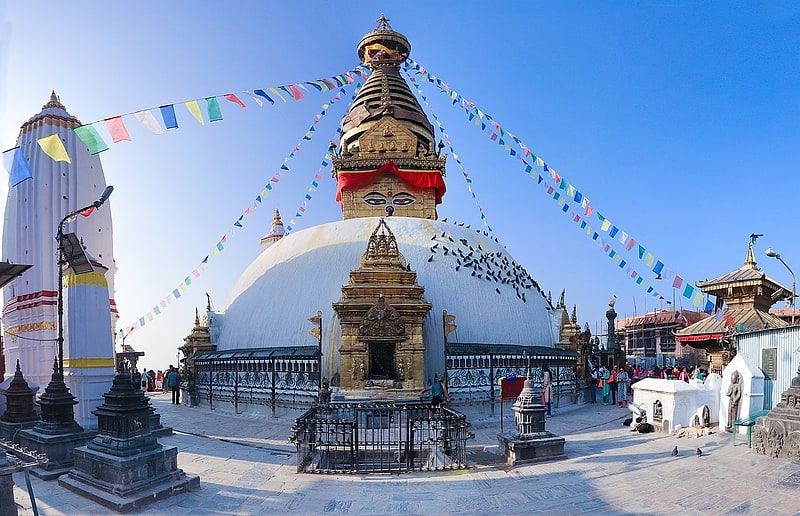
Also known as: स्वयम्भूनाथ
Storied temple complex and pilgrimage site. Swayambhu is an ancient religious complex atop a hill in the Kathmandu Valley, west of Kathmandu city. The Tibetan name for the site means 'Sublime Trees', for the many varieties of trees found on the hill. However, Shing.kun may be of the local Nepal Bhasa name for the complex, Swayambhu, meaning 'self-sprung'. For the Buddhist Newars, in whose mythological history and origin myth as well as day-to-day religious practice Swayambhunath occupies a central position, it is probably the most sacred among Buddhist pilgrimage sites. For Tibetans and followers of Tibetan Buddhism, it is second only to Boudha. Swayambhunath is the Hindu name.
The complex consists of a stupa, a variety of shrines and temples, some dating back to the Licchavi period. A Tibetan monastery, museum and library are more recent additions. The stupa has Buddha's eyes and eyebrows painted on. Between them, the number one (in Devanagari script) is painted in the fashion of a nose. There are also shops, restaurants and hostels. The site has two access points: a long staircase leading directly to the main platform of the temple, which is from the top of the hill to the east; and a car road around the hill from the south leading to the south-west entrance. The first sight on reaching the top of the stairway is the Vajra. Tsultrim Allione describes the experience:
We were breathless and sweating as we stumbled up the last steep steps and practically fell upon the biggest vajra (thunderbolt scepter) that I have ever seen. Behind this Vajra was the vast, round, white dome of the stupa, like a full solid skirt, at the top of which were two giant Buddha eyes wisely looking out over the peaceful valley which was just beginning to come alive.
Much of Swayambhunath's iconography comes from the Vajrayana tradition of Newar Buddhism. However, the complex is an important site for Buddhists of many schools, and is also revered by Hindus.[2]
Address: Swayamhu Circle Road, 44620 Kathmandu
Kathmandu Durbar Square
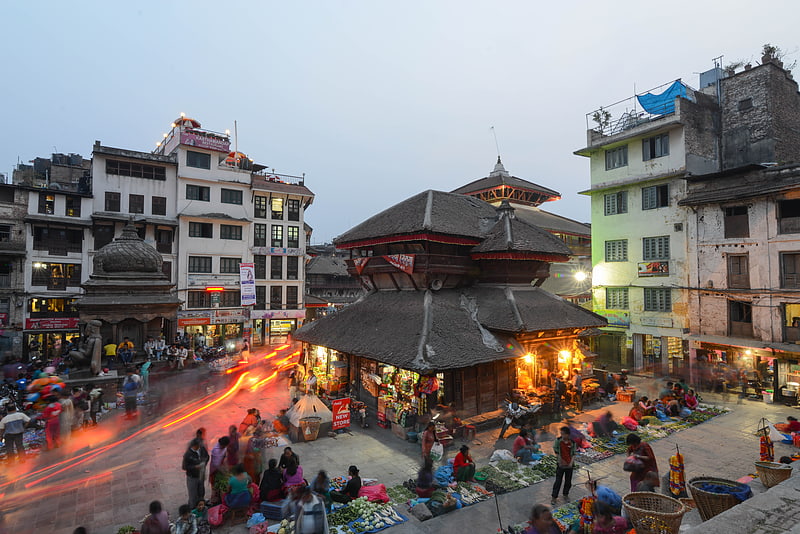
Also known as: वसन्तपुर दरबार क्षेत्र
Historical landmark in Kathmandu, Nepal. Kathmandu Durbar Square in front of the old royal palace of the former Kathmandu Kingdom is one of three Durbar Squares in the Kathmandu Valley in Nepal, all of which are UNESCO World Heritage Sites.
Several buildings in the Square collapsed due to a major earthquake on 25 April 2015. Durbar Square was surrounded with spectacular architecture and vividly showcases the skills of the Newar artists and craftsmen over several centuries. The Royal Palace was originally at Dattaraya square and was later moved to the Durbar square.
The Kathmandu Durbar Square held the palaces of the Malla and Shah kings who ruled over the city. Along with these palaces, the square surrounds quadrangles, revealing courtyards and temples. It is known as Hanuman Dhoka Durbar Square, a name derived from a statue of Hanuman, the monkey devotee of Lord Ram, at the entrance of the palace.[3]
Address: Ganga Path, 44600 Kathamndu
Changu Narayan Temple

Also known as: चाँगुनारायण मन्दिर
Ancient Hindu temple honoring Vishnu. The ancient Hindu temple of Changu Narayan is located on a high hilltop that is also known as Changu or Dolagiri. The temple was surrounded by champak tree forest and a small village known as Changu. The temple is located in Changunarayan Municipality of Bhaktapur District, Nepal. This hill is about 7 miles or 12 km east of Kathmandu and a few miles north of Bhaktapur. The Manohara River flows beside the hill. This shrine is dedicated to lord Visnu and held in special reverence by the Hindu people. This temple is considered to be the oldest temple in the history of Nepal. The Kashmiri king gave his daughter, Champak, in marriage to the prince of Bhaktapur. Changu Narayan Temple is named after her.[4]
Narayanhiti Palace Museum
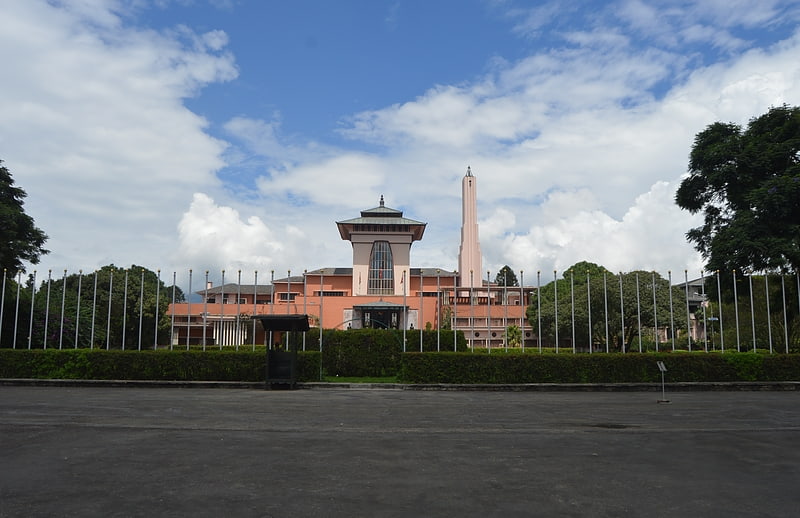
Museum in Kathmandu, Nepal. The Narayanhiti Palace Museum is a public museum in Kathmandu, Nepal located east of the Kaiser Mahal and next to Thamel. The museum was created in 2008 from the complex of the former Narayanhiti Palace following the 2006 revolution. Before the revolution, the palace was the residence and principal workplace of the monarch of the Kingdom of Nepal, and hosted occasions of state.
The existing palace complex was built by King Mahendra in 1963, and incorporates an impressive array of courtyards, gardens and buildings.[5]
Address: Durbar Marg, 44600 Kathmandu
Shiva Parvati Temple
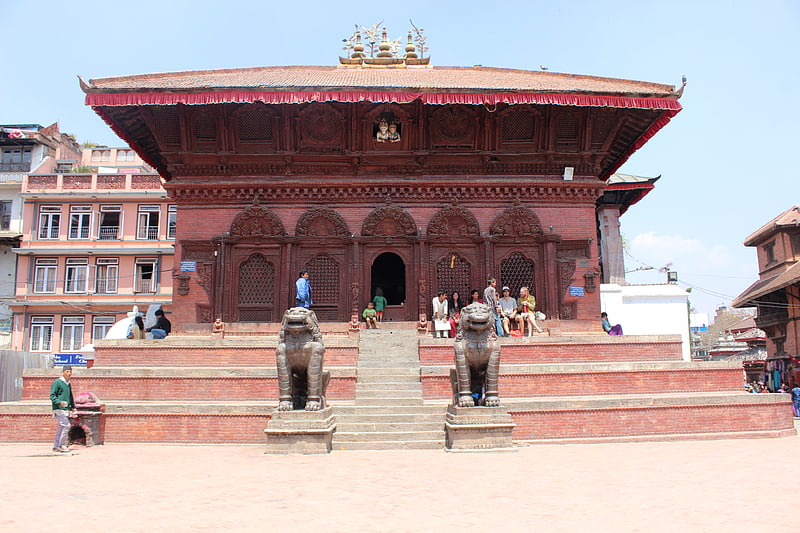
Hindu temple in Kathmandu, Nepal. Shiva Parvati Temple is a Hindu temple located in Kathmandu Durbar Square, Nepal.
It was built by Bahadur Shah, son of Nepal's first king Prithvi Narayan Shah. The temple survived the April 2015 Nepal earthquake.[6]
Taleju Temple
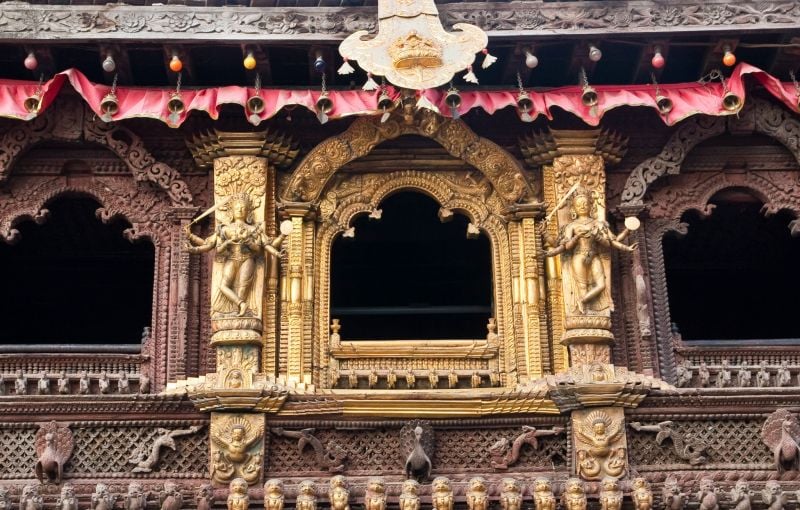
Taleju Temple is a Hindu temple dedicated to Taleju Bhawani, the royal goddess of the Malla dynasty of Nepal. It was built in 1564 by Mahendra Malla and is located in Hanuman Dhoka, Kathmandu Durbar Square, a UNESCO World Heritage Site. Inside the temple, there is a shire dedicated to Taleju Bhawani, and Kumari Devi. Taleju Temple is only opened once a year on the occasion of Dashain.[7]
Maju Dega
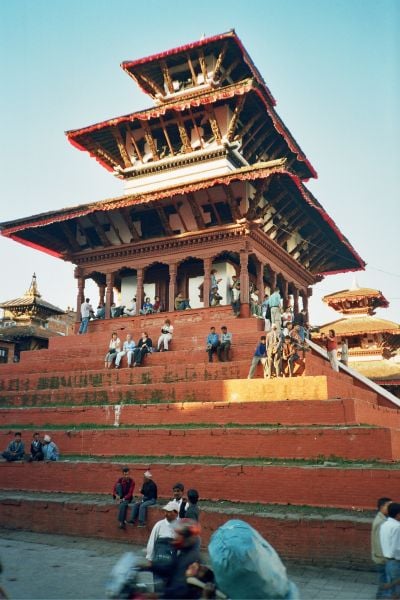
Hindu temple in Kathmandu, Nepal. Maju Dega is a Hindu temple dedicated to Shiva and it is located in Kathmandu Durbar Square, Nepal.
The temple was built by Riddhi Lakshmi, the Queen mother of Bhupetendra Malla in 1692. 1971 Indian film Haré Rama Haré Krishna was filmed on premises of the temple. The April 2015 Nepal earthquake completely destroyed the temple and it was being rebuilt in 2018.[8]
Hanuman Dhoka

Also known as: हनुमान ढोका
Hindu temple in Kathmandu, Nepal. Hanuman Dhoka is a complex of structures with the Royal Palace of the Malla kings and also of the Shah dynasty in the Durbar Square of central Kathmandu, Nepal. It is spread over five acres. The Hanuman Dhoka Palace gets its name from the stone image of Hanuman, the Hindu deity, that sits near the main entryway. 'Dhoka' means door or gate in Nepali. The buildings were severely damaged in the 2015 earthquake.[9]
Address: Durbar Square, 44600 Kathmandu
Asan

Asan is a ceremonial, market and residential square in central Kathmandu, the capital of Nepal. It is one of the most well-known historical locations in the city and is famed for its bazaar, festival calendar and strategic location. Asan has been described as one of the fine Newar examples of a traditional Asian bazaar. The Tuladhar, Maharjan, Shrestha, Bajracharya and Shakya castes make up most of the population.
Six streets converge on Asan giving the square a perpetual bustle. The bazaar at Asan attracts shoppers from all over Kathmandu because of the tremendous variety of merchandise sold here, ranging from foodstuffs, spices and textiles to electronics and bullion.
Asan is also one of the popular tourist spots in the city because of its architectural sights and charming ambiance. There are banks, restaurants and a post office. Two taxi stands and bus stops are situated on the eastern side.[10]
Address: Between Durbar Square and Thamel, 44600 Kathmandu
Bagh Bhairab Temple

Hindu temple in Kirtipur, Nepal. Bagh Bhairab Temple is a historic Hindu temple dedicated to Bagh Bhairab, an incarnation of Shiva as a tiger. It is located in Kirtipur, Bagmati Province, Nepal and dates back to the 16th century. The residents of Kiritpur believe that Bagh Bhairab protects the town. Bagh Bhairab Temple features the swords used by King of Gorkha Prithvi Narayan Shah's army during the Battle of Kirtipur.[11]
Address: चिठु मार्ग, 44600 Kirtipur
Budhanilkantha Temple
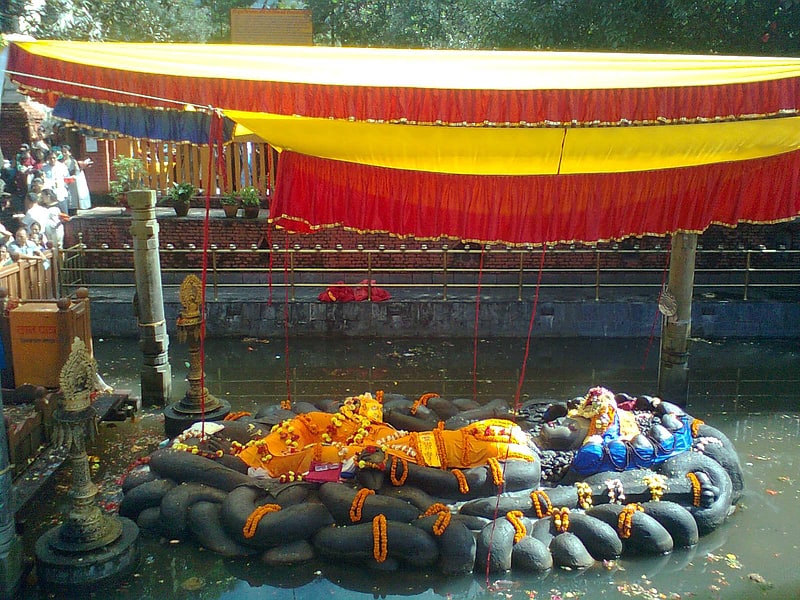
Also known as: बूढानीलकण्ठ मन्दिर
Hindu temple in Nepal. Budhanilkantha Temple, located in Budhanilkantha, Nepal, is a Hindu open air temple dedicated to Lord Mahavishnu. Budhanilkantha Temple is situated below the Shivapuri Hill at the northern end of the Kathmandu valley. and can be identified by a large reclining statue of Lord Mahavishnu. The temple's main statue of Budhanilkantha is considered the largest stone carving in Nepal.[12]
Address: ca. 9 km sudlich von Kathmandu., 44600 Kathmandu
Taudaha Lake
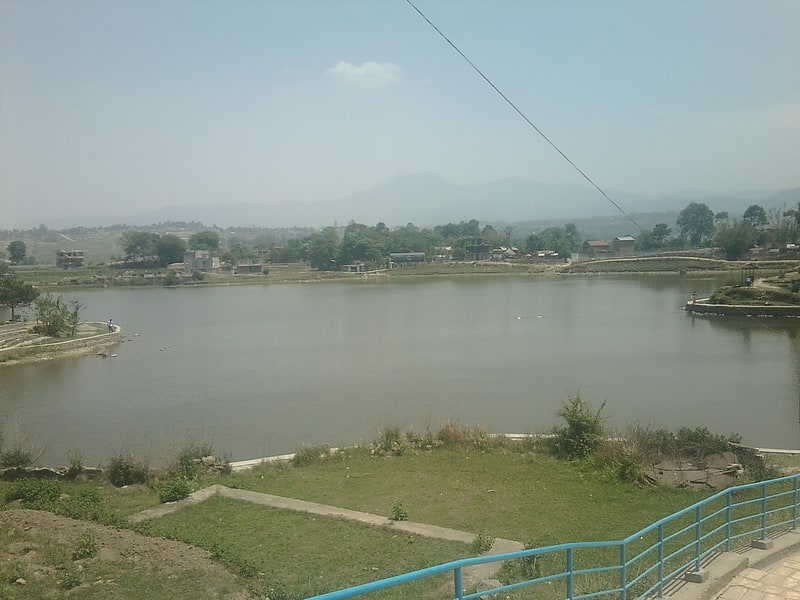
Also known as: टौदह
Lake in Nepal. Taudaha Lake is a small lake in the outskirts of Kathmandu, in Nepal. The name comes from a combination of Newari words 'Ta', meaning snake and 'Daha', which means lake.[13]
Natural History Museum of Nepal
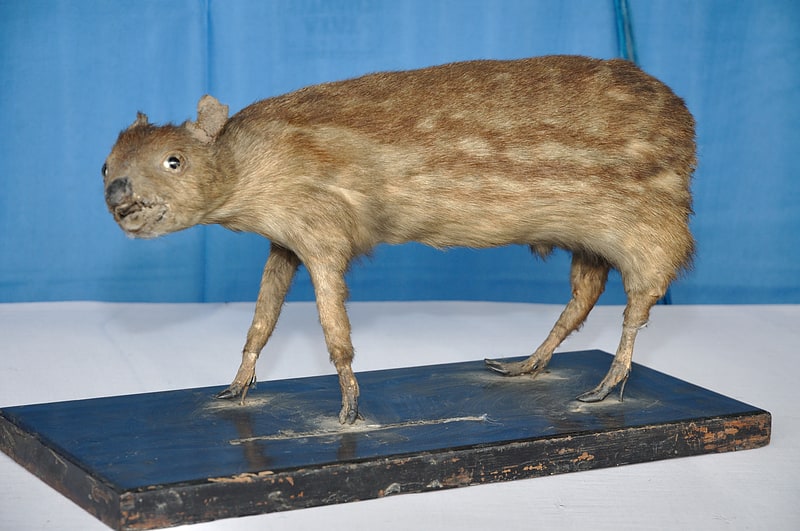
Also known as: प्राकृतिक इतिहास संग्रहालय नेपाल
Museum in Kathmandu, Nepal. The Natural History Museum of Nepal is located near the World Heritage Site of Swayambhunath. The museum was established in 1975. Since then the museum has collected 50,000 specimens of Nepal’s flora and fauna.[14]
Address: Manjushree Bajaar, 44600 Kathmandu
Adinath Lokeshwar
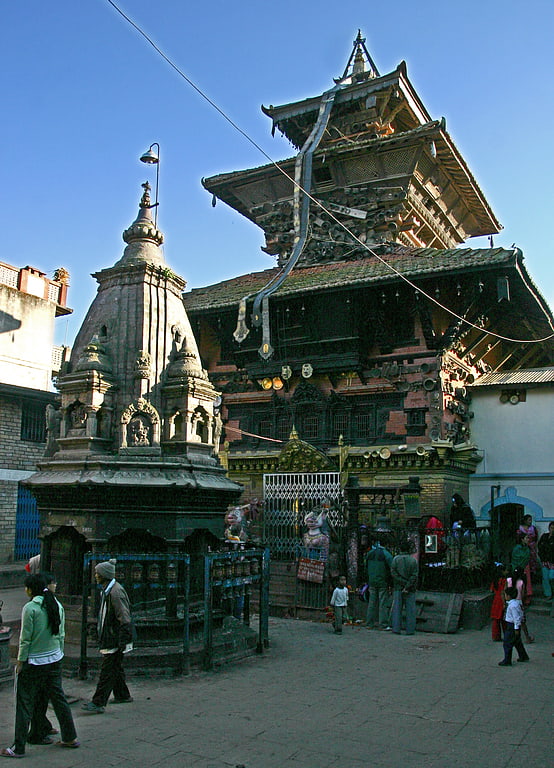
Anandadi Lokeshwar Mandir is a temple sacred to Hindus and Buddhists in the village of Chobar, outside Kathmandu in Nepal. The temple is dedicated to Anandadi Lokeshwar, one of four principal Bodhisattvas honored as Lokeshwars in the Kathmandu Valley. It was built in the 15th century, then rebuilt in 1640. Tourists often refer to this as the "pots and pans" temple, due to all of the domestic implements affixed to its walls. Accounts for this custom vary, but all relate to the welfare of the deceased in the afterlife.
"There are various legends connected to the deity. The story begins with the coming of Manjusri to the valley to drain the lake and make the valley habitable. Manjusri, who has taken the name of Manjudeva for his sojourn, comes to the valley and cuts the rim of the hills near a low hill called Kacchapala Giri, the hill of Chobar. The deity inhabiting the hill is angry because he is being cut by Manjudeva, but Manju retorts that he should be glad as once the lake has been drained away, the Valley will become the seat of a great civilization and one day Sri Tin Lokeshvara will come to take up residence on the hill of Chobar. Many eons later, when the Valley had become a center of civilization and was being ruled by a king called Dharmakara, Manjusri decided to return to the valley as Manjudeva to pay a visit to Sri Tin Jyotirupa Swoyambhu. He brought with him Kasyapa Tathagata. The two of them decided to set up a Vihara in the Valley to teach and advise the people. They set up a vihara called Pim Baha, located in a place thereafter called Manjupattana. In order that the proper worship of himself and Kasyapa Tathagata might be insured he selected a certain acharya, instructed him in the ritual and appointed him and his descendants as official deo palas (priestly attendant, dyah pālā in Newa). Manjusri became known to the people there as Adinath.
"After several generations, disputes arose among the descendants of this Acharya about who had the right to serve as dea palas in the temple. It was finally decided that the dependents would serve in the temple by turn. By this time, it was Kali Yuga and the two deities decided that if they continued to reside in the temple and converse openly and freely with men as they had been doing, the people will eventually give them a lot of trouble. So they decided to disappear into their images and communicate no more with the people except by work, i.e. they would continue to grant favors to the people but would not speak and converse with them. The next morning when the deo pala came to perform the customary worship he found only dumb statues. He began to cry and people gathered. Finally, the relatives of the deo palas held a council and decided that this disaster must be due to some failing of the del palas and killed them all, except for one old man. The old man went up to the temple and rebuked the gods: "What is the use of doing puja to gods like you; my whole family has been destroyed. Henceforth I will not worship you." In a rage, he took out the images and all ornaments and threw the image of Kasyapa Tathagata into the river at Shanti Tirtha and that of Adinath he cast into the river at Arya Tirtha. In the bank of the river one Hem Acharya, was meditating and saw these articles flowing down the river. By force of his Sadhana removed the image of Kasyapa Tathagata from the river, took it to Patan and installed it in a Baha which is called Hemavarna Mahavihara or Kwa Baha.
"The image of Adinath carried on down the river to a place called Jaya Tirtha where a man called Suval Acharya was meditating. Seeing this thing washed along by the river, he realized the life of Adinath Karunamaya and put it into a Kalasa. The life came floating to him in the form of a jasmine flower. Taking the Kalasa to the Kacchapala Hill at Chobhar, he transferred it into an image and called it Anandadi Lokeshvara. At the end of a year, he decided to have an annual bathing ceremony for the image and set the date as the first day of the bright half of the month of Chaitra, the anniversary of the day on which he had removed the life of god from the image in the river."[15]
Address: Chobhar, Kathmandu
Gokarna Mahadev
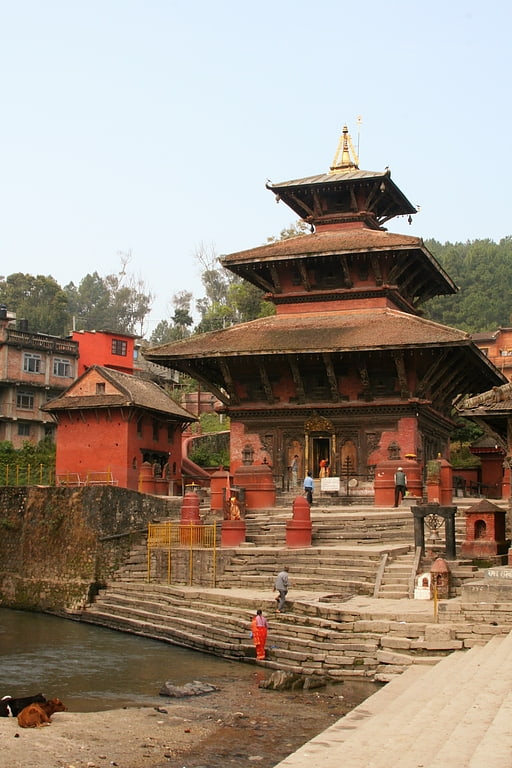
Gokarna Mahadev or Gokarneshwor Mahadev Temple is an important Nepali temple, situated near the village of Gokarna, several kilometers northeast of Bodhnath in the Kathmandu Valley. Within the temple's sanctum lies an important lingam of the Hindu god Shiva, but its fame relies mainly on the collection of statues and carvings around the temple.[16]
Garden of Dreams
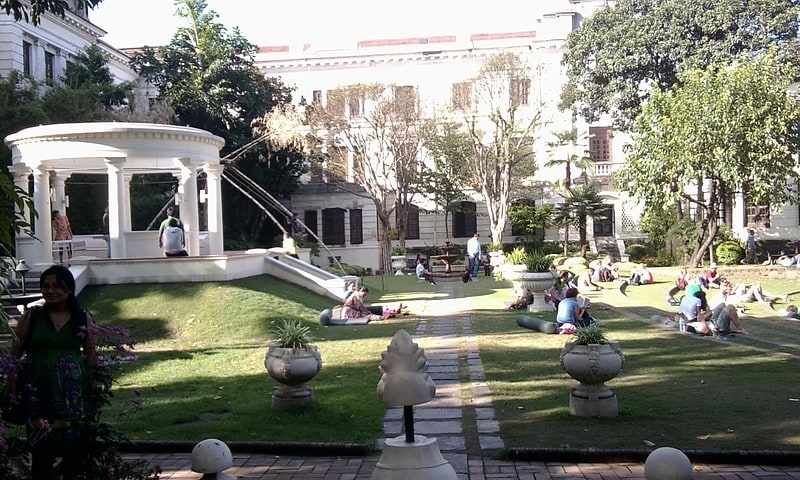
Also known as: स्वप्न बगैंचा
Tourist attraction in Kathmandu, Nepal. The Garden of Dreams, also, the Garden of Six Seasons, is a neo-classical garden in Kaiser Mahal Kathmandu, Nepal, built in 1920. Designed by Kishore Narshingh, it consists of 6,895 square metres of gardens with three pavilions, an amphitheater, ponds, pergolas, and urns. From the mid-1960s, upon the death of its patron, Kaiser Sumsher Rana, it lay in neglect but was recently restored with the help of the Austrian government.[17]
Dharahara
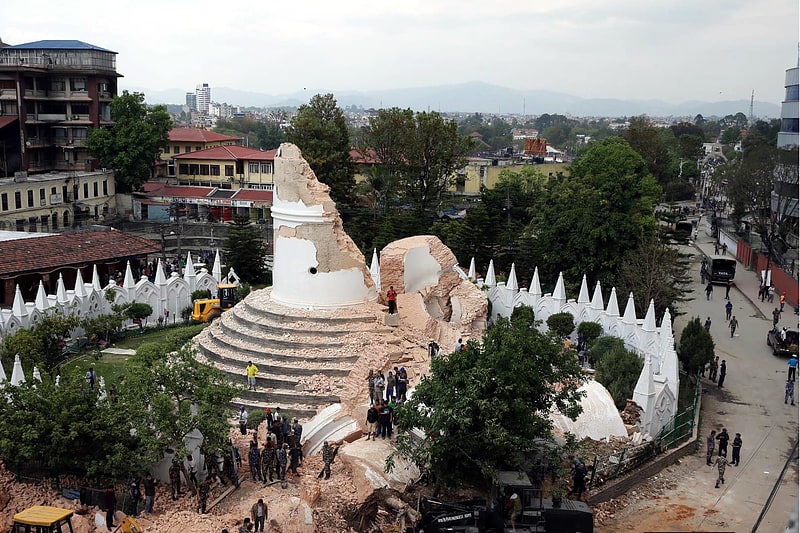
Also known as: धरहरा
Tower in Kathmandu, Nepal. Dharahara, also called Bhimsen Sthambha, is a twenty two-storey, 72-metre-tall tower at the centre of Sundhara, Kathmandu, Nepal. It was first built in 1832 by Mukhtiyar Bhimsen Thapa under the commission of Queen Lalit Tripurasundari and was a part of the architecture of Kathmandu recognized by UNESCO. It has been damaged and reconstructed several times.
The tower had a spiral staircase containing 213 steps. The eighth floor held a circular balcony for observers that provided a panoramic view of the Kathmandu valley. It also had a 5.2-metre (17 ft) bronze mast on the roof.
Most of the tower collapsed in the 25 April 2015 Nepal earthquake, but the base remains.A total of 180 bodies were retrieved from the debris of tower after earthquake. Reconstruction of the tower commenced in October 2018, and it was officially opened on 24 April 2021, one day before the sixth anniversary of the earthquake.[18]
Address: Sundhara ganabahal, Kathmandu
Akash Bhairav
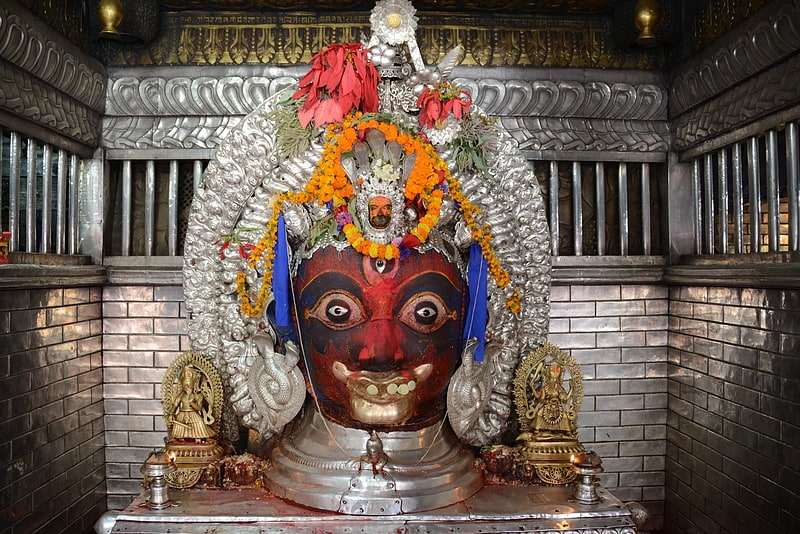
Also known as: आकाशभैरव
Akash Bhairav or Aaju is one of the different forms of Bhairava.
The temple of Akash Bhairav is supposed to have been a palace of the first king of Nepal, Kiranti King Yalambar around 3100–3500 years back. The surrounding of Akash Bhairav is known as Yen to symbolize Ne of Nepal. Ne means Midland in Kiranti language. The head of the Aakash Bhairav was dug up several hundred years ago in Kathmandu. It is taken out once a year on the occasion of Yenya Festival and blessed by the Kumari, the living goddess who lives in the nearby Kumarichok. This ceremony is held in the month of August/September. During the ceremony, large number of worshippers come to visit this temple. They offer Peda (sweets made from milk), flowers, money and several others things. We could have witnessed the late dynasty exchanging the swords with that of Akash Bhairav. Most recently by the previous king Gyanendra of Nepal and late King Birendra of Nepal before him. In reality, they had made the offering and shown deep respect towards the historic icon.[19]
Address: Indra Chowk, 44600 Kathmandu
Charumati Stupa
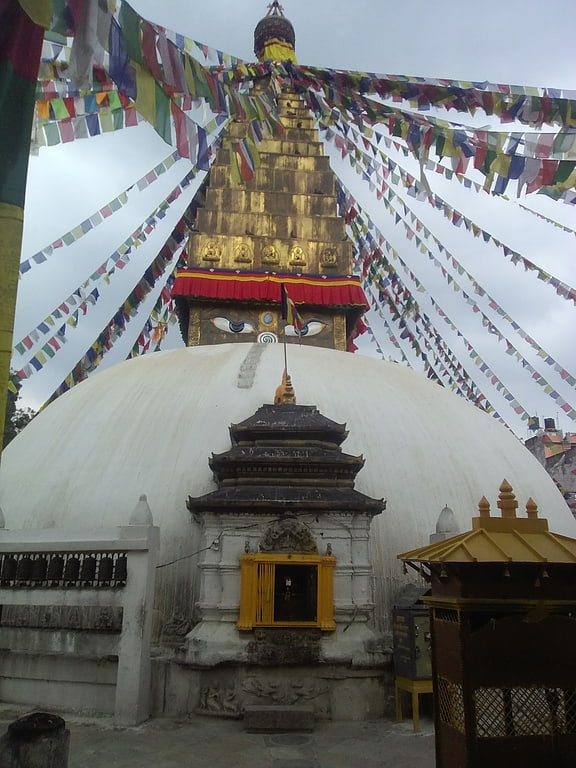
Monastery in Kathmandu, Nepal. Charumati Stupa is a stupa in Kathmandu, Nepal.
It was built by Charumati, daughter of the Indian emperor Ashoka, in the 4th century. In 2003, Charumati Stupa was restored by the locals as it was crumbling due to the "heavy vehicular traffic on the nearby road". During its restoration process countless artefacts, coins, and manuscripts were found possibly dating back to the Licchavi era. It was again restored in 2015 due to the April 2015 Nepal earthquake.[20]
Durbar Square
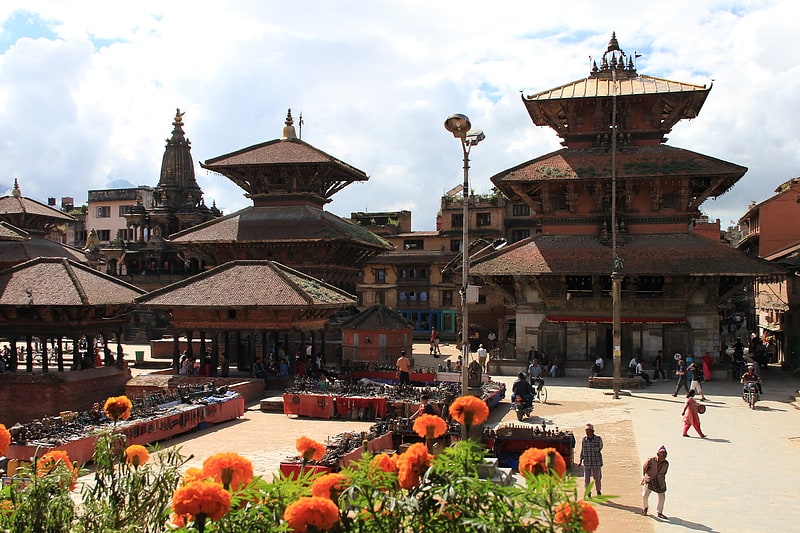
Also known as: काठमाडौं
Durbar Square, which means Royal Squares in English, is the generic name used to describe plazas and areas opposite the old royal palaces in Nepal. The name comes from Persian دربار. It consists of temples, idols, open courts, water fountains and more. Before the Unification of Nepal, Nepal consisted of small kingdoms, and Durbar Squares are most prominent remnants of those old kingdoms in Nepal. In particular, three Durbar Squares in the Kathmandu Valley, belonging to the three Newar kingdoms situated there before unification, are most famous: Kathmandu Durbar Square, Patan Durbar Square, and Bhaktapur Durbar Square. All three are UNESCO World Heritage Sites.These sites have received significant damage due to the devastating earthquake of 2015 but most structures still remain.
- Durbar Square
Aircraft Museum Kathmandu

Aircraft Museum Kathmandu is an aviation museum located in Sinamangal, Kathmandu, Nepal. The museum is inside an Airbus A330-300 of Turkish Airlines that only flew for about eight months before suffering a runway excursion at Tribhuvan International Airport in Kathmandu in March 2015. It was established under a joint initiative by the Civil Aviation Authority of Nepal and pilot Bed Upreti and his trust. This museum was officially opened to public on 28 November, 2017. The museum's exhibits include the aircraft's original cockpit setting, model and miniature aircraft and items documenting the history of Nepalese aviation. The museum is the second of its kind in Nepal, after Bed Upreti had already set up a similar, yet smaller aviation museum, the Aircraft Museum Dhangadhi in Dhangadhi in Western Nepal. The museum cost around NPRs 70 million.[22]
Kumari Temple

Hindu temple in Kathmandu, Nepal. The Kumari Temple is a local Hindu temple located in Samakhusi, Nepal. This is a local temple where people can gather and organize small events, function, Vivaah and many other activities.
The temple has a 3-story building to store the things as well as conduct the Yoga. This is also place for old people service center where people can sing Bhajan and Dance. This is extremely helpful for the old people to pass the time.
Local people of Samakhusi, where they can not go far for their Prayers they come here to Pray. From this temple name the area also named as kumari tole.[23]
Pancha Kashmiri Takiya Masjid

The Pancha Kashmiri Takiya Masjid commonly known as the Kashmiri Masjid, build in 15th century AD, is one of the oldest mosques of Nepal.
Muslims from Kashmir entered Nepal for trade during the time of king Ratna Malla and the mosque was built in the time of king Pratap Malla. The mosque has undergone multiple renovations. More Kashmiri people came to Kathmandu due to violence in Kashmire. The current mosque was built in the times of king Prithvi Narayan Shah after the Muslims helped him to spy on Malla rulers.
The mosque has three complexes viz. a prayer hall, an annexe and a madrasah. The tombs of Haji Mishkin Shah and Khwaja Gyasuddin Shah are inside the premises.[24]
Address: Durbar Marg, Kathmandu
Babar Mahal

Babar Mahal, Baber Mahal is a Rana palace in Kathmandu, the capital of Nepal. The palace complex, located north of the Bagmati river, was incorporated in an impressive and vast array of courtyards, gardens and buildings. Initially the palace was under Jung Bahadur Rana's Thapathali Durbar but later was separated and demolished and rebuilt by Chandra Shumsher Jang Bahadur Rana, as prime minister and the executive leader of Nepal.[25]
Balkumari temple
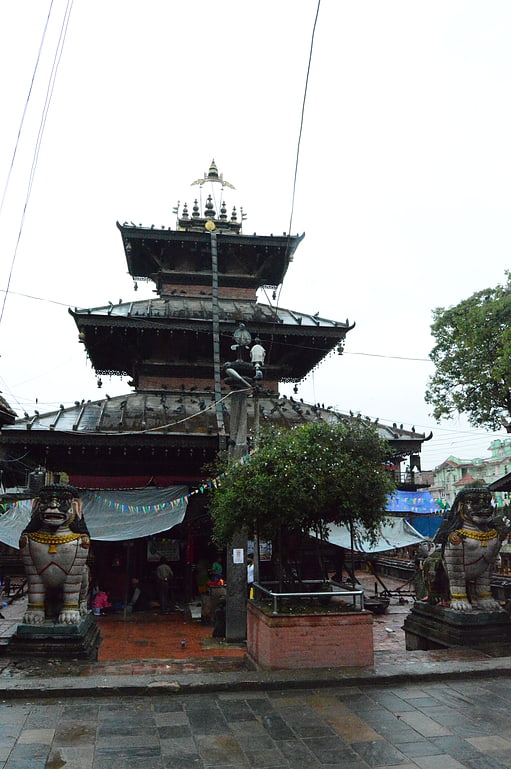
Balkumari Temple is located in Lalitpur District in Nepal. The origin of temple is controversial,but is supposed to be built between 7 and 17th century. There is a pond near the temple which has been filled with silt and is under restoration.
The original idol of Balkumari was stolen and has not been recovered. The duplicate copy has also been stolen a few times but has been returned.
The temple is a starting point of Pyakhaa Jatra which ends after 3 days in Sunakothi. The festival occurs after about a month from Holi.[26]
Boudhanath
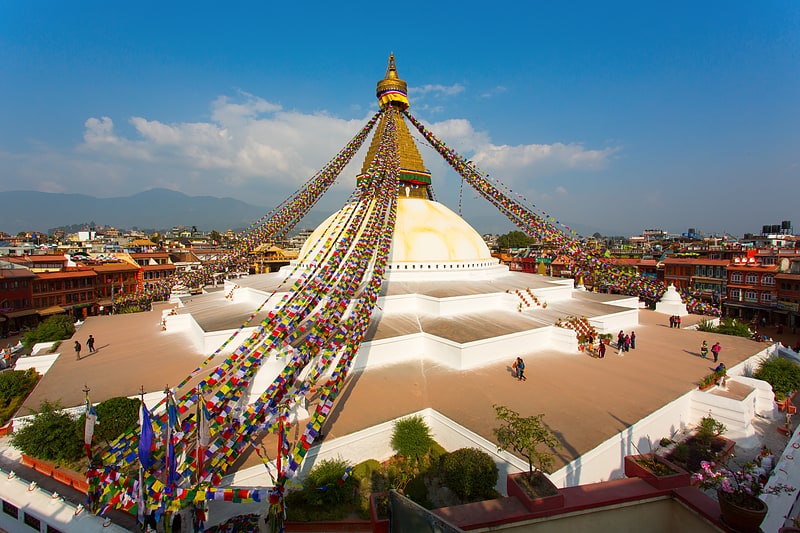
Also known as: बौद्धनाथ
Huge, dome-topped Buddhist temple. Bouddha, also known as Boudhanath, Khasti Chaitya and Khāsa Chaitya is a stupa in Kathmandu, Nepal. Located about 11 km from the center and northeastern outskirts of Kathmandu, its massive mandala makes it one of the largest spherical stupas in Nepal and the world.
The influx of large populations of refugees from Tibet has seen the construction of over 50 gompas (Tibetan monastery) around Boudha. As of 1979, Boudha Stupa is a UNESCO World Heritage Site. Along with Swayambhu, it is one of the most popular tourist sites in the Kathmandu area.
The stupa is on the ancient trade route from Tibet which enters the Kathmandu Valley by the village of Sankhu in the northeast corner and continues to the ancient and smaller stupa of Chabahil named Charumati Stupa (often called "Little Boudhanath"). It then turns directly south, heading over the Bagmati River to Lalitpur, bypassing the main city of Kathmandu (which was built later). Tibetan merchants have rested and offered prayers at Boudha Stupa for many centuries. When refugees entered Nepal from Tibet in the 1950s, many decided to live around Boudhanath. The stupa is said to entomb the remains of Kassapa Buddha.[27]
Kaal Bhairav
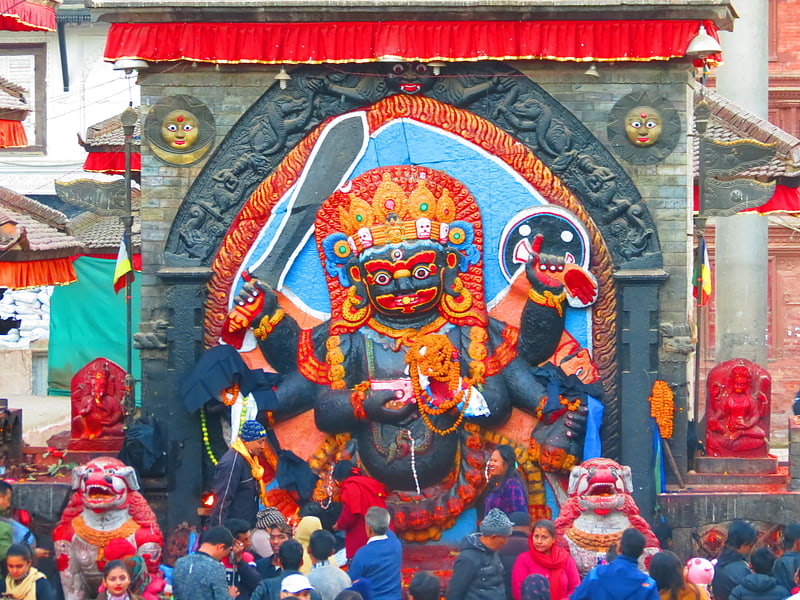
Kaal Bhairav is a Hindu shrine located in Kathmandu Durbar Square, a UNESCO World Heritage Site. According to legend, the shrine was found at a paddy field and later it was placed at the Durbar Square by King Pratap Malla. Kaal Bhairav is believed to have been sculptured from a single stone.[28]
Jal Binayak Temple

Also known as: जलविनायक
Hindu temple in Kirtipur, Nepal. Jal Binayak is a Hindu Temple of Lord Ganesh located in the Chobhar, central part of Kathmandu District, Nepal. The Jal Binayak temple is the most important Ganesh shrine of the central region Kathmandu. It is one of the four Binayak of Kathmandu Valley.[29]
Singha Sattal
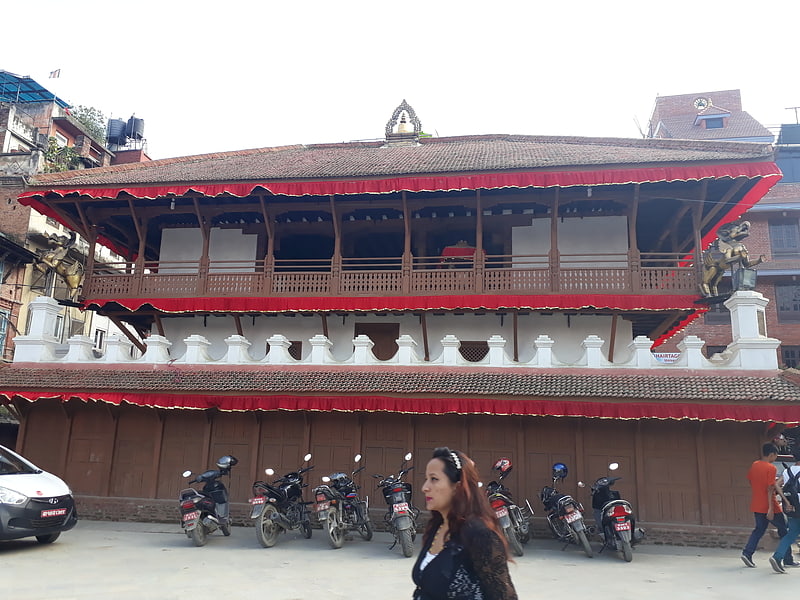
Singha Sattal, also known as Silyan Sattal is a 13th-century shelter located in the Kathmandu Durbar Square and It was built alongside the iconic Kasthamandap. Singha Sattal is owned by Guthi Sansthan, a state-owned enterprise. In the corners of the shelter, there are four bronze lions.[30]
Kopan Monastery
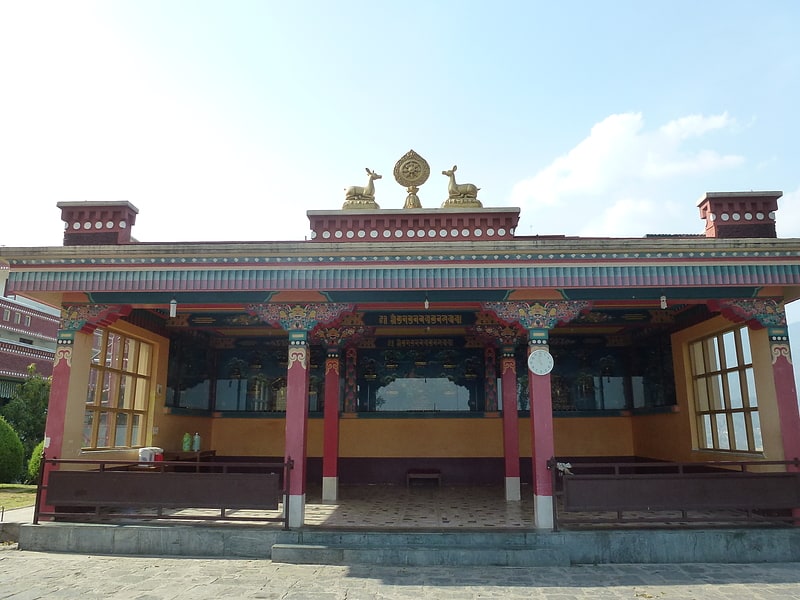
Tibetan Buddhist courses and retreats. Kopan Monastery is a Tibetan Buddhist monastery near Boudhanath, on the outskirts of Kathmandu, Nepal. It is a member of the Foundation for the Preservation of the Mahayana Tradition, an international network of Gelugpa dharma centers, and once served as its headquarters.
The monastery was established by the FPMT's founders, Lamas Thubten Yeshe and Thubten Zopa Rinpoche, who bought the property from Nepal's royal astrologer in 1969. Its name comes from the name of the hill on which it was built.
Kopan has become especially famous for teaching Buddhism to visiting Western foreigners. The first of what would become annual month-long (November–December) meditation courses was held in 1971. These courses generally combine traditional Lam Rim teachings with informal discussion, several periods of guided meditation, and a vegetarian diet.
Kopan now encompasses two separate institutions: the monastery, atop Kopan Hill, and the nearby Khachoe Ghakyil Ling Nunnery (known as the Kopan Nunnery). The nunnery was established in 1979 by Lama Yeshe to provide spiritual and practical education modeled on that received by the monks. In 2009 the nunnery began raising money to expand its housing and education capacity, which has grown from 4 to 400 in less than 35 years, using such sites as GoFundMe.
Kopan Monastery has also recently become a popular recreational destination for Kathmandu residents and tourists. On Saturdays it regularly receives hundreds of visitors from 10 AM to 4 PM. The monastery is not open to the public on other days of the week.[31]
Address: North of Boudhanath, Kathmandu
Jhor waterfall

Jhor waterfall is located in the northern hills of Kathmandu near Tokha. The stream from Shivapuri National Park feeds the waterfall. The waterfall is about 11 km from Ring Road from Samakhushi. There is a temple of Shiva near the waterfall which opens on Saturdays and Mondays. There is also a zipline near the waterfall that was constructed to boost the tourism.
The waterfall is close to the city, hence it attracts people from Kathmandu, especially during the summer.[32]
Dakshinkali Temple
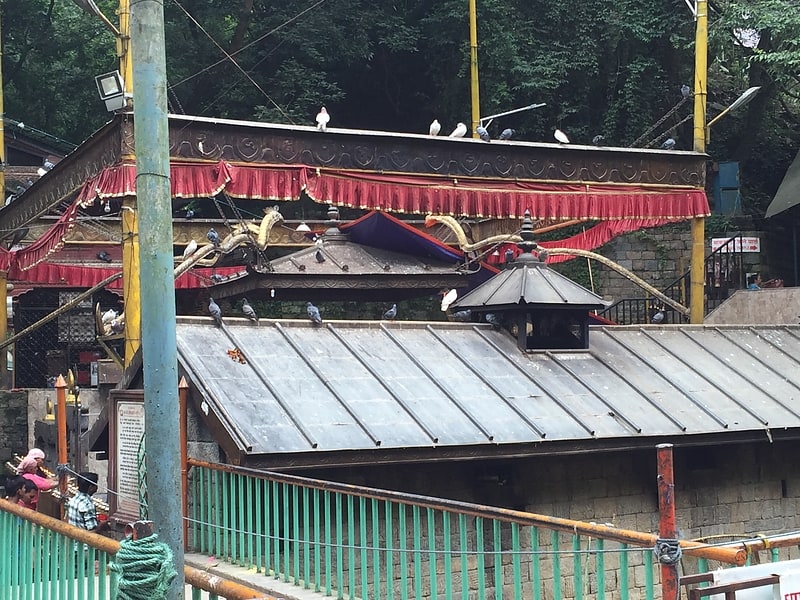
Hindu temple in Dakshinkali, Nepal. Dakshinkali Temple, also Dakshin Kali Temple or Dakshina Kali Temple, located 22 kilometres outside Kathmandu and about 1 kilometre outside the village of Pharping, is one of the major Hindu temples in Nepal dedicated to the goddess Kali. Dakshin Kali is typically shown with her right foot on Shiva's chest—while depictions showing Kali with her left foot on Shiva's chest depict the even more fearsome Vamakali. Animal sacrifices, particularly of cockerels and uncastrated male goats, are the main way that the goddess is worshipped, and this is especially seen during the Dashain festival. Dakshin Kali Temple has also the same religious value as Pashupatinath Temple and Manakamana Temple in Nepal. The temple has more tourist attraction as it is a popular hiking destination located near Pharping village in Nepal. Mother Dakshinakali is the most popular form of Kali. She is the benevolent mother, who protects her devotees and children from mishaps and misfortunes.
There are various stories explaining the origin of the name Dakshinakali. Dakshina refers to the gift given to a priest before performing a ritual or to one's guru. Such gifts are traditionally given with the right hand. Dakshinakali's two right hands are usually depicted in gestures of blessing and giving of boons. One version of the origin of her name comes from the story of Yama, lord of death, who lives in the south (dakshina). When Yama heard Kali's name, he fled in terror, and so those who worship Kali are said to be able to overcome death itself. This temple is also situated in the south (dakshin) part of Kathmandu valley.[33]
Pharping
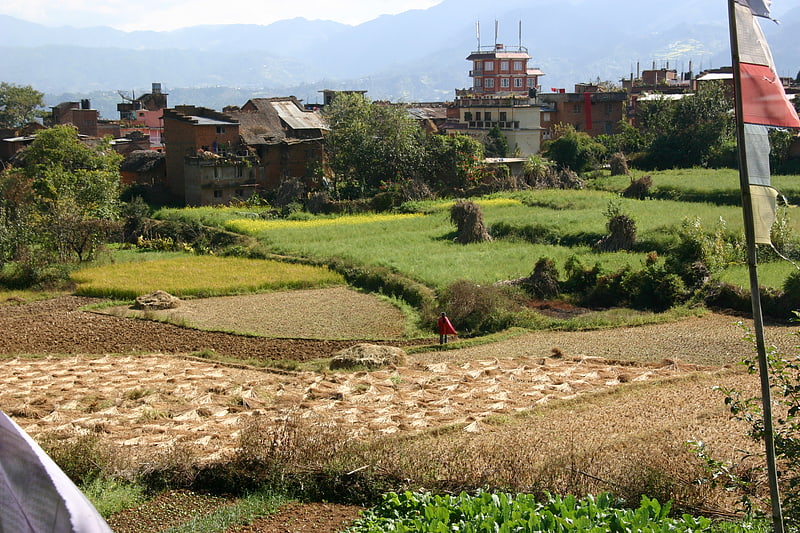
Pharping is a small Newar town lying above the Bagmati river on the southern edge of the Kathmandu valley, about 23 km from the capital. It is now part of the Dakshinkali Municipality.
The town and its environs is the site of several important Buddhist pilgrimage sites as well as a number of Buddhist monasteries and meditation retreat centres.
About 1 km south of the town is the Dakshinkali Temple, one of the main Hindu temples of Nepal dedicated to the mother goddess Kali.
Pharping is also the site of the oldest hydroelectric power station in Nepal which is now a living museum.[34]
Ka-Nying Shedrub Ling
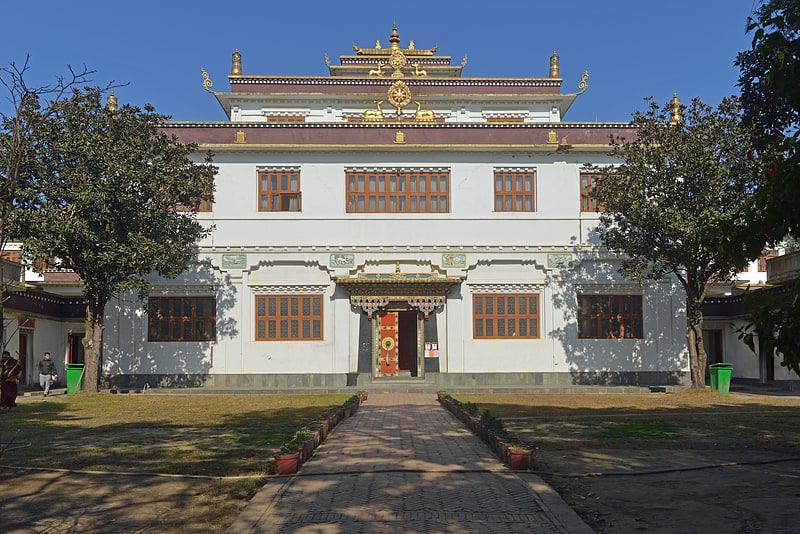
Ka-Nying Shedrub Ling is a Tibetan Buddhist monastery near Boudhanath, on the outskirts of Kathmandu, Nepal. It has ties to both the Kagyu and Nyingma schools, hence the combined Ka-Nying in the name. Shedrub Ling means “sanctuary for learning and practice.”[35]
Address: North of Boudha, Kathmandu